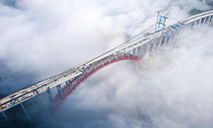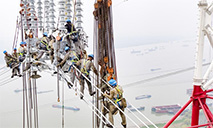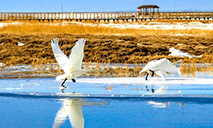Rare infrared cameras capture video footage showcasing mother leopard raising her cubs in the wild
Infrared cameras installed at the Ziwuling National Nature Reserve in Yan’an, northwest China’s Shaanxi Province have captured video clips showing a wild leopard mother raising her three cubs, including breastfeeding the cubs and feeding them some meat.
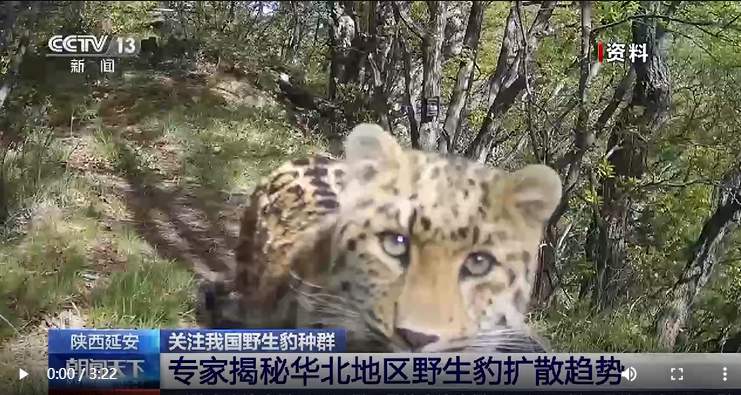
(Photo/CCTV News)
Experts say these video clips are the first of their kind to have been collected by a nature reserve in the country and record a day in the life of a mother leopard and her young cubs through the use of infrared cameras.
“We think that the leopard cubs are about three months old because they can move within only a small area and therefore the mother has to find a hiding place to keep her offspring safe. When the cubs were about five months old, they will begin to hunt with their mother,” said Feng Limin, deputy director of the monitoring and research center of Siberian tigers and Amur leopards under the National Forestry and Grassland Administration.
“As we can see in the videos, the mother leopard and her three babies first walked toward the cameras and then stayed around there for a whole day. One video clip captured earlier that day showed a leopard cub drinking milk from its mother, while in another video clip captured later that day, the same cub was eating meat brought to it by its mother,” said Feng, who is also an associate professor at Beijing Normal University, which installed the infrared cameras in the nature reserve to research the animals and their habitats.
The video clips record the process the leopard cubs underwent to transition from drinking milk to eating meat, offering up exquisite details hitherto unseen. The videos captured an important visual record of a significant growth stage in the life of wild leopards, with scarcely no other such records previously in extent, Feng explained, suggesting that the videos are the first of their kind collected by researchers in China.
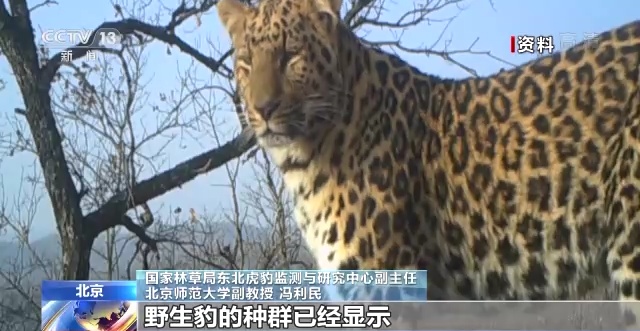
(Photo/CCTV News)
Leopards are under first-class state protection in China. The fact that the leopard family chose to stay for a whole day near an infrared camera, which had been placed near the site of a former residential community, indicates that the ecological environment of the nature reserve is sound and that the nature reserve has done an excellent job protecting wild animals, experts say.
“The ecosystem and the living environment for wild animals have been effectively protected at the nature reserve. Because the nature reserve is almost free of human activities, it provides a safe habitat for the leopards, and that’s also why we managed to observe and capture images of the animals there,” said Feng.
The forest ecosystems in mountainous regions of northern China are the major habitats for wild leopards. However, the wild leopard population underwent a sharp decrease over a short period of time in years past. In recent years, however, as the country made stronger efforts to ensure environmental protection, the forested and vegetated ecosystems that comprise the habitats of leopards have recovered remarkably, with the population of wild leopards having bounced back accordingly.
“After monitoring and surveying wild leopards in the Ziwuling Mountains for a period of nearly 10 years, we discovered that the number of wild leopards there exceeded 110, while the population density of the animal has surpassed more than 2.4 wild leopards per 100 square kilometers of land,” Feng introduced.
Photos
Related Stories
- Lucky leopard in Chinese TV drama becomes instant-hit in China as symbol for getting rich quick
- In pics: baby leopard in park in Bhopal, India
- Snow leopards roam into hydropower station
- 6 persons sentenced to jail after leopards escape safari park in east China
- Chinese researchers develop AI-aided tech for snow leopard protection
- Rescued snow leopard released back into the wild
- Wild leopard spotted in Chinese nature reserve
- Snow leopard spotted in SW China
- Snow leopard recorded by camera in SW China
- Amur leopard spotted in NE China reserve
Copyright © 2022 People's Daily Online. All Rights Reserved.








